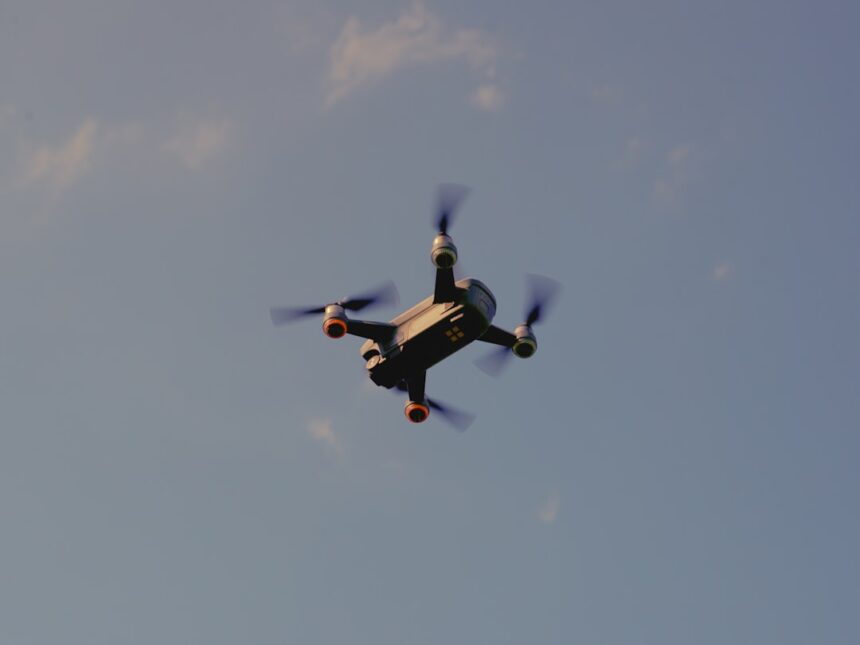Frequency hopping drones represent a significant advancement in the realm of unmanned aerial vehicles (UAVs). These drones utilize a technique known as frequency hopping spread spectrum (FHSS), which allows them to rapidly switch between different frequency channels during operation. This method not only enhances the resilience of the drone’s communication systems against interference but also makes it more challenging for adversaries to intercept or jam signals.
By continuously changing frequencies, these drones can maintain a stable connection with their operators while evading detection and disruption. The operational advantages of frequency hopping drones are manifold. They can be employed in various applications, from military reconnaissance to commercial delivery services.
Their ability to operate in contested environments, where traditional communication methods may falter, makes them invaluable assets. As the technology continues to evolve, the potential for frequency hopping drones to revolutionize industries and enhance security measures becomes increasingly apparent. Understanding the intricacies of this technology is crucial for stakeholders across sectors, as it lays the groundwork for addressing the challenges and threats posed by their use.
Key Takeaways
- Frequency hopping drones use a technique to rapidly switch between radio frequencies to avoid detection and interception.
- The threat posed by frequency hopping drones includes surveillance, espionage, and potential weaponization.
- Traditional defense systems are vulnerable to frequency hopping drones due to their reliance on fixed frequencies for communication and tracking.
- Advanced detection and tracking technologies, such as wideband receivers and cognitive radio systems, are being developed to counter frequency hopping drones.
- Jamming and spoofing countermeasures, encryption, and frequency agility are key strategies for defending against frequency hopping drones.
Identifying the Threat
As frequency hopping drones become more prevalent, the potential threats they pose must be carefully assessed. These drones can be utilized for nefarious purposes, including surveillance, smuggling, and even targeted attacks. Their ability to evade traditional detection systems complicates efforts to identify and neutralize these threats before they materialize.
The challenge lies not only in recognizing the drones themselves but also in understanding the intentions of those who operate them. Moreover, the proliferation of frequency hopping technology has democratized access to advanced drone capabilities. This means that not only state actors but also non-state actors and individuals with malicious intent can exploit these systems.
The implications for national security are profound, as adversaries can leverage these drones to gather intelligence or disrupt critical infrastructure without being easily detected. Identifying the threat landscape surrounding frequency hopping drones is essential for developing effective countermeasures and ensuring public safety.
Vulnerabilities in Traditional Defense Systems

Traditional defense systems often struggle to keep pace with the rapid advancements in drone technology, particularly with frequency hopping capabilities. Many existing radar and detection systems are designed to track conventional aircraft and may not be equipped to handle the unique challenges posed by these agile UAVs. The reliance on fixed frequency bands makes it easier for frequency hopping drones to evade detection, as they can simply switch frequencies to avoid being tracked.
Additionally, traditional defense mechanisms may lack the adaptability required to respond to the dynamic nature of frequency hopping operations. As these drones change frequencies, they can exploit gaps in surveillance coverage, rendering conventional systems ineffective. This vulnerability highlights the need for a reevaluation of current defense strategies and technologies to ensure they can adequately address the evolving threat landscape posed by frequency hopping drones.
Advanced Detection and Tracking Technologies
| Technology | Metrics |
|---|---|
| Radar Systems | Range, Accuracy, Resolution |
| Lidar Systems | Point Cloud Density, Range, Angular Resolution |
| Computer Vision | Object Detection Accuracy, Frame Rate, Processing Time |
| Sonar Systems | Frequency, Range, Resolution |
In response to the challenges presented by frequency hopping drones, researchers and defense experts are developing advanced detection and tracking technologies. These innovations aim to enhance situational awareness and improve the ability to identify and neutralize UAV threats. One promising approach involves the use of multi-sensor fusion, which combines data from various sources, such as radar, electro-optical sensors, and signal intelligence, to create a comprehensive picture of the operational environment.
Another emerging technology is machine learning algorithms that can analyze patterns in drone behavior and predict their movements. By leveraging vast amounts of data, these algorithms can identify anomalies that may indicate the presence of a frequency hopping drone. This proactive approach allows defense systems to respond more effectively to potential threats before they escalate.
As these technologies continue to mature, they hold the potential to significantly enhance the capabilities of defense forces in countering frequency hopping drones.
Jamming and Spoofing Countermeasures
Jamming and spoofing are two primary countermeasures employed against frequency hopping drones. Jamming involves disrupting the communication signals between the drone and its operator, rendering it unable to receive commands or transmit data. However, due to the nature of frequency hopping technology, jamming efforts must be sophisticated enough to keep pace with the rapid changes in frequency.
This requires advanced equipment capable of detecting and targeting multiple frequencies simultaneously. Spoofing, on the other hand, involves deceiving a drone into believing it is receiving legitimate signals from its operator when, in fact, it is being controlled by an adversary. This tactic can be particularly effective against frequency hopping drones if the spoofing system can mimic the legitimate control signals accurately.
However, both jamming and spoofing come with their own set of challenges and limitations, necessitating ongoing research and development to enhance their effectiveness against increasingly sophisticated drone technologies.
Encryption and Frequency Agility

Encryption plays a critical role in securing communications between frequency hopping drones and their operators. By employing robust encryption protocols, operators can protect their data from interception and unauthorized access. This is particularly important in military applications where sensitive information may be transmitted during operations.
The integration of encryption with frequency agility further enhances security by ensuring that even if an adversary manages to intercept a signal, they would still face significant challenges in deciphering the encrypted data. Moreover, as frequency hopping technology evolves, so too must encryption methods. The development of quantum encryption techniques holds promise for providing an unprecedented level of security against potential threats.
By leveraging the principles of quantum mechanics, these methods could create communication channels that are virtually unbreakable. As such technologies become more accessible, they will play a pivotal role in safeguarding frequency hopping drone operations from interception and exploitation.
Utilizing Artificial Intelligence for Defense
Artificial intelligence (AI) is poised to revolutionize drone defense strategies by enhancing detection, tracking, and response capabilities. AI algorithms can analyze vast amounts of data from various sources in real-time, enabling defense systems to identify potential threats more quickly and accurately than ever before. Machine learning models can be trained on historical data to recognize patterns associated with frequency hopping drone activity, allowing for proactive measures to be taken before an incident occurs.
Furthermore, AI can facilitate automated responses to detected threats. For instance, once a frequency hopping drone is identified, AI-driven systems could initiate countermeasures such as jamming or deploying interceptors without requiring human intervention. This level of automation not only increases response speed but also reduces the cognitive load on operators during high-stress situations.
As AI technology continues to advance, its integration into drone defense systems will likely become increasingly sophisticated and essential.
Collaborative Defense Strategies
Addressing the challenges posed by frequency hopping drones requires a collaborative approach among various stakeholders, including government agencies, private sector companies, and international partners. By sharing information and resources, these entities can develop comprehensive strategies that enhance overall security against UAV threats. Collaborative efforts can lead to the establishment of standardized protocols for detection and response, ensuring that all parties are equipped to handle potential incidents effectively.
Additionally, joint training exercises can help improve coordination among different organizations involved in drone defense. By simulating real-world scenarios involving frequency hopping drones, participants can refine their tactics and strategies while fostering communication and collaboration across sectors. Such partnerships not only strengthen individual capabilities but also contribute to a more resilient defense posture against emerging threats.
Regulatory and Legal Considerations
The rise of frequency hopping drones has prompted discussions around regulatory and legal frameworks governing their use. As these technologies become more widespread, policymakers must grapple with issues related to privacy, airspace management, and liability in case of incidents involving UAVs. Striking a balance between fostering innovation and ensuring public safety is paramount in developing effective regulations that address the unique challenges posed by frequency hopping drones.
Moreover, international cooperation is essential in establishing norms and standards for drone operations across borders. As frequency hopping technology transcends national boundaries, harmonizing regulations will help mitigate risks associated with cross-border drone activities. Engaging stakeholders from various sectors—including industry experts, legal scholars, and government representatives—will be crucial in shaping a regulatory landscape that promotes responsible use while safeguarding public interests.
Training and Preparedness for Frequency Hopping Drone Defense
Effective training programs are vital for preparing personnel tasked with defending against frequency hopping drones. These programs should encompass a range of topics, including understanding drone technology, recognizing potential threats, and implementing countermeasures effectively. Simulated training exercises can provide hands-on experience in dealing with real-world scenarios involving UAVs, allowing operators to hone their skills in a controlled environment.
Additionally, ongoing education is essential as technology continues to evolve rapidly. Regular updates on emerging trends in drone technology and defense strategies will ensure that personnel remain informed about best practices and new developments in the field. By fostering a culture of continuous learning and adaptability within defense organizations, they can better prepare for the challenges posed by frequency hopping drones.
Future Developments in Drone Defense Technology
The future of drone defense technology is poised for significant advancements as researchers continue to explore innovative solutions to counter emerging threats. One area of focus is the development of next-generation radar systems capable of detecting low-flying UAVs operating on frequency-hopping protocols. These systems will likely incorporate advanced signal processing techniques that enhance their ability to track agile targets effectively.
Moreover, as artificial intelligence becomes increasingly integrated into defense systems, future developments may include autonomous drones designed specifically for counter-drone operations. These UAVs could be equipped with advanced sensors and algorithms that enable them to detect and neutralize hostile frequency hopping drones autonomously. As technology continues to advance at an unprecedented pace, staying ahead of potential threats will require ongoing investment in research and development within the field of drone defense.
In conclusion, addressing the challenges posed by frequency hopping drones necessitates a multifaceted approach that encompasses technological innovation, regulatory frameworks, collaborative strategies, and comprehensive training programs. As this technology continues to evolve, stakeholders must remain vigilant in adapting their defenses to ensure public safety while harnessing the benefits that drones offer across various sectors.
These drones utilize advanced techniques to switch frequencies, making it difficult for traditional jamming systems to intercept their signals. An insightful article that delves into the intricacies of this issue can be found on In The War Room’s website. This article explores various strategies and technologies being developed to effectively counter these agile drones. For a deeper understanding, you can read more about these innovative solutions by visiting inthewarroom.
com/’>In The War Room.
FAQs
What are frequency hopping drones?
Frequency hopping drones are unmanned aerial vehicles (UAVs) equipped with technology that allows them to rapidly switch between different radio frequencies in order to avoid detection and interception.
Why is countering frequency hopping drones important?
Countering frequency hopping drones is important because they pose a significant challenge to traditional methods of drone detection and interception. Without effective countermeasures, these drones can be used for unauthorized surveillance, smuggling, or even malicious attacks.
What are some methods for countering frequency hopping drones?
Some methods for countering frequency hopping drones include using advanced signal processing and analysis techniques, developing specialized anti-drone technology, and implementing regulations and restrictions on drone usage in sensitive areas.
What are the challenges in countering frequency hopping drones?
The challenges in countering frequency hopping drones include the complexity of their communication systems, the rapid and unpredictable nature of frequency hopping, and the need for advanced technology and expertise to effectively detect and intercept these drones.
What are the potential risks associated with frequency hopping drones?
The potential risks associated with frequency hopping drones include unauthorized surveillance of sensitive areas, smuggling of contraband or illegal goods, and the potential for malicious attacks using drones as delivery vehicles for harmful payloads.




